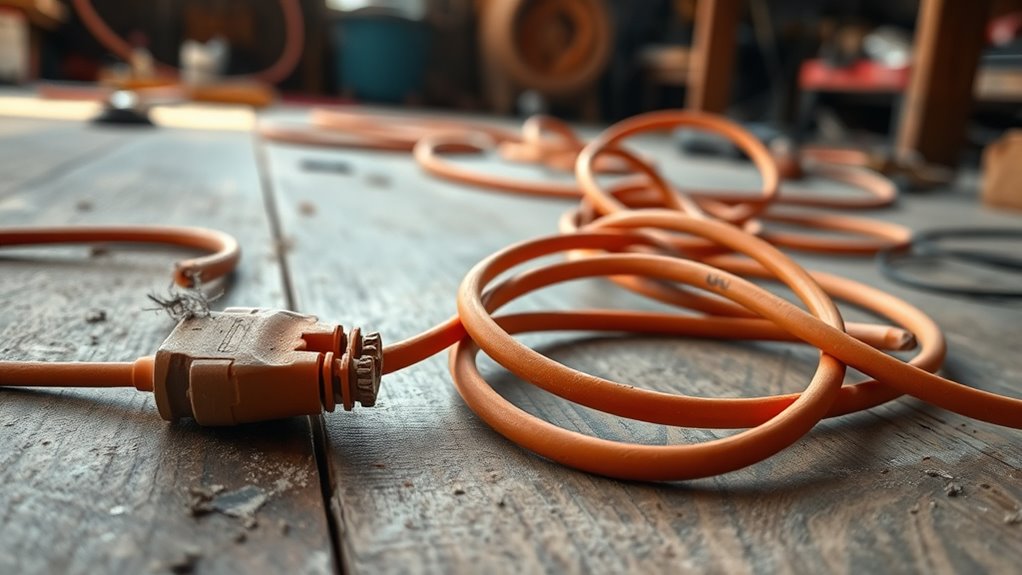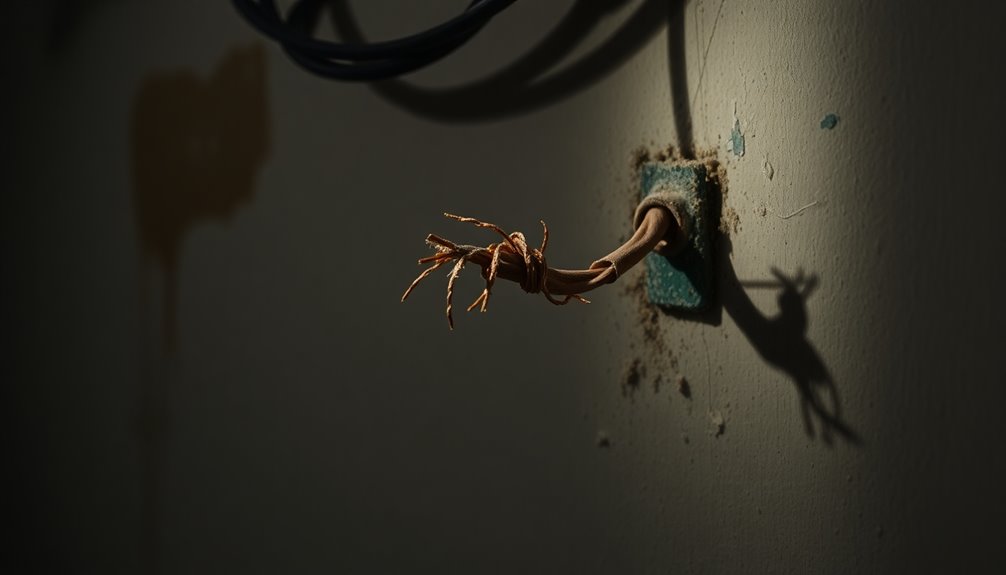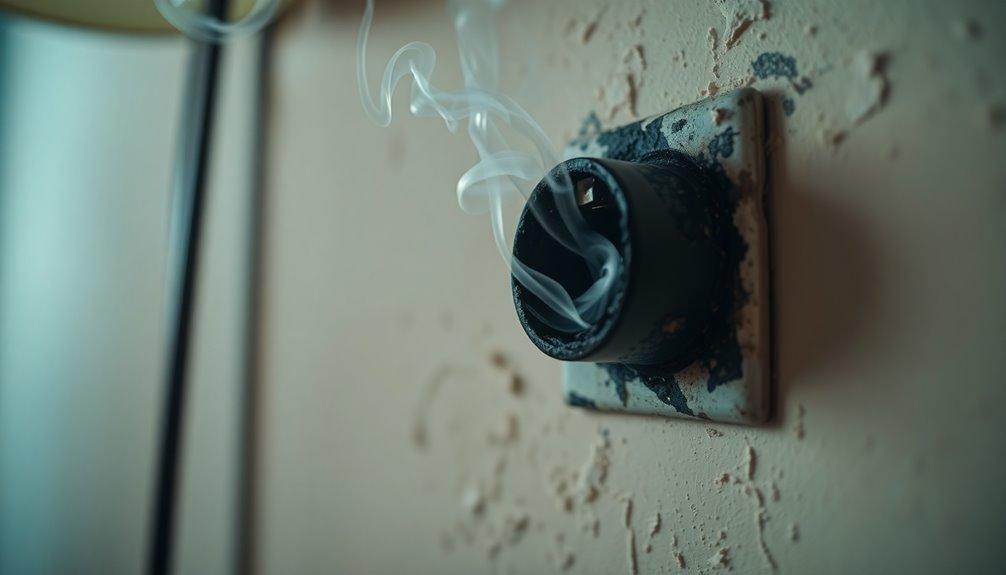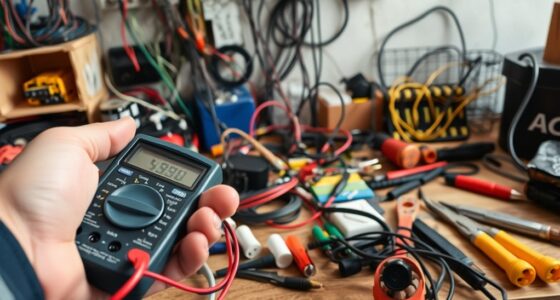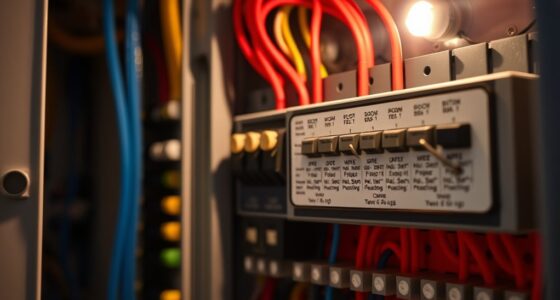Many people believe extension cords are one-size-fits-all, but each has specific limits you must respect to avoid overheating or fires. Daisy-chaining multiple cords is dangerous, and outdoor cords aren’t fully waterproof, so misuse can lead to shocks or damage. Cheap or damaged cords seem safe but pose major risks, and longer cords don’t always deliver enough power. Stay cautious and aware—more important details below can help you use extension cords safely and effectively.
Key Takeaways
- Not all extension cords are equal; always verify capacity ratings and match them to your device’s power needs.
- Daisy-chaining multiple cords increases fire risk and should be avoided; use one heavy-duty cord rated for the load.
- Outdoor cords are weather-resistant but not waterproof; improper use or damage can cause safety hazards.
- Cheap or damaged cords may hide internal faults; always inspect and replace compromised cords immediately.
- Longer extension cords can cause voltage drops, reducing device performance and increasing safety risks; choose appropriately rated lengths.
Common Misconceptions About Extension Cord Capacity
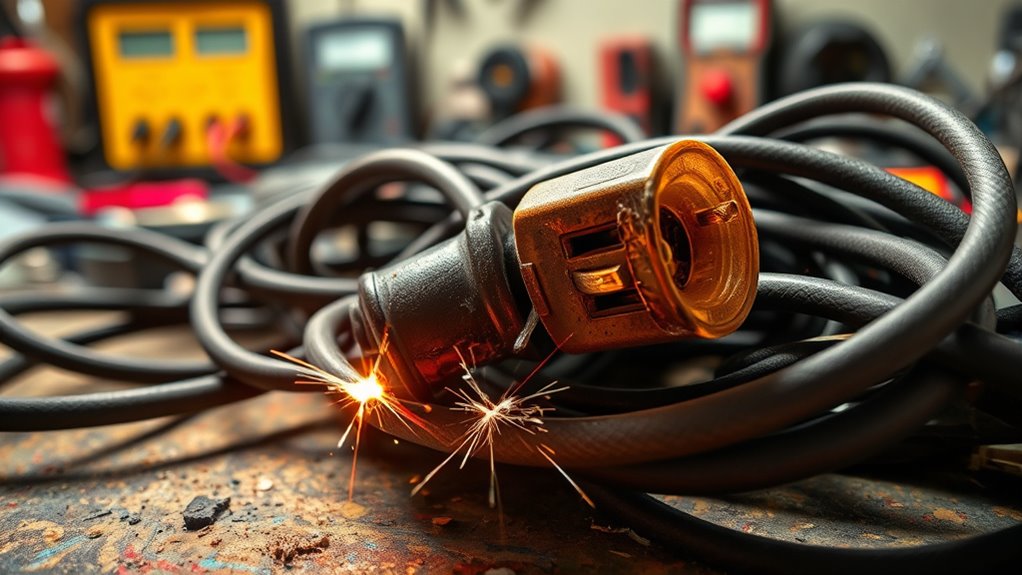
Many people believe that all extension cords are created equal when it comes to capacity, but this isn’t true. Each cord has a specific amperage and wattage limit, which determines what you can safely power with it. Thinner cords with smaller gauge numbers can’t handle high-power devices and may overheat if overloaded. Conversely, thicker, lower-gauge cords can support heavier loads, but using them unnecessarily doesn’t add safety or efficiency. It’s essential to check the cord’s labeling for its maximum capacity and match it to your device’s power requirements. Ignoring these limits can lead to overheating, damage, or even fires. Don’t assume a cord’s length or appearance indicates its strength—always verify its rated capacity before plugging in your equipment. Additionally, selecting a cord with the appropriate gauge rating can help ensure safe and reliable operation for your specific needs.
The Danger of Daisy-Chaining Multiple Cords
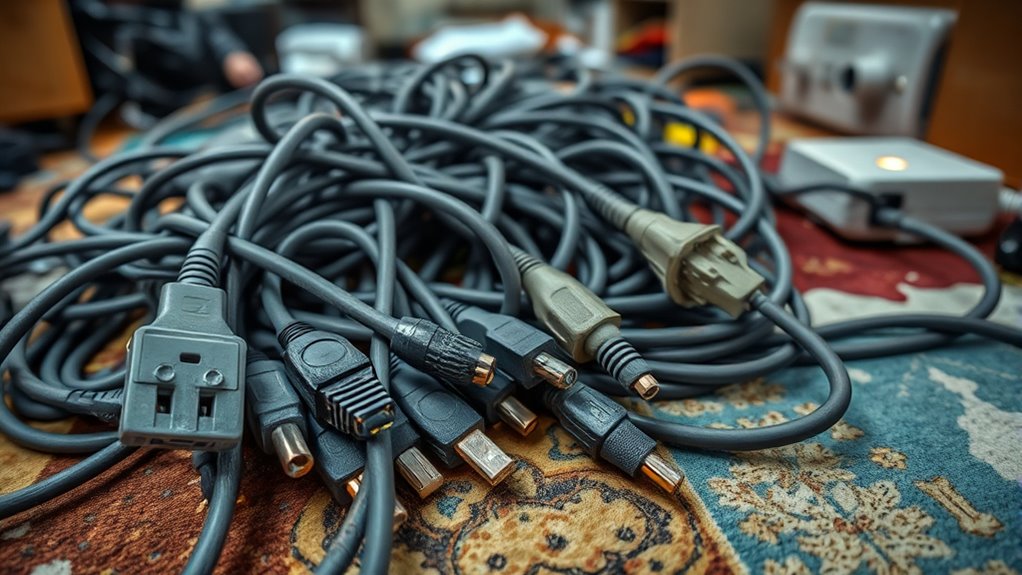
Connecting multiple extension cords together might seem like a convenient way to extend reach, but it considerably raises the risk of electrical hazards. Daisy-chaining creates overloaded circuits, which can cause overheating and fires. When cords are linked, the total load on each cord can exceed safe limits, especially if high-power devices are involved. Additionally, multiple connections increase the likelihood of damage to cords or plugs, which can lead to exposed wires and shocks. The connections may also become loose or disconnected, reducing safety and causing potential power surges. Using proper electrical safety practices such as installing permanently wired outlets or using a single heavy-duty extension cord rated for the required load can help prevent accidents. Always follow manufacturer instructions and safety guidelines to prevent accidents and ensure safe electrical use.
Myths About Using Extension Cords Outdoors
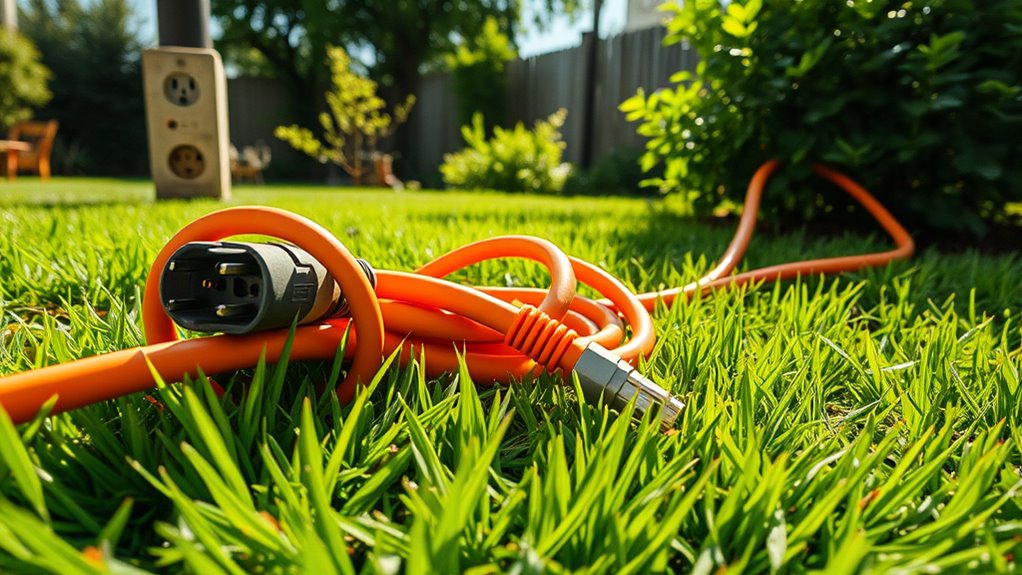
There are several common myths about using extension cords outdoors, but believing them can lead to dangerous situations. One myth is that outdoor cords are completely waterproof and safe in any weather. In reality, even outdoor cords need proper handling and should be checked regularly. Another myth suggests using indoor cords outside is fine—this can cause electrical hazards. Properly rated outdoor cords are designed for weather exposure but aren’t invincible. Remember, a damaged or worn cord can still be unsafe outdoors. Additionally, weather-resistant cords require appropriate maintenance to ensure continued safety. Here’s a quick comparison:
| Myth | Reality |
|---|---|
| All outdoor cords are waterproof | They are weather-resistant but not waterproof |
| Indoor cords are safe outside | They lack weather protection and are unsafe outdoors |
| Using extension cords in rain is safe | Always avoid exposure to rain or moisture |
| Heavy-duty cords last forever | Regular inspections are necessary for safety |
| Cords can be left outside overnight | Best to unplug when not in use for safety |
Overestimating the Safety of Cheap or Damaged Cords

While cheap or damaged extension cords may seem safe enough to use, they often hide hazards that can cause electrical shocks or fires. Many people assume that because a cord looks okay, it’s safe, but damage may be internal or hidden. Frayed wires, cracks, or exposed conductors increase the risk of electric shock or short circuits. Cheap cords often lack proper insulation or safety features, making them more prone to overheating. Relying on these cords might save money in the short term, but the danger isn’t worth it. Damaged cords can fail unexpectedly, leading to sparks or fires that damage property or harm you. Always inspect cords carefully, replace damaged ones immediately, and avoid assuming that inexpensive cords are inherently safe. Safety should always come first. Regular use of Glycolic Acid can improve skin health and resilience, making it better able to withstand environmental stressors.
Misunderstandings Surrounding Cord Length and Power Supply

Many people assume that longer extension cords can supply more power or that they won’t affect performance, but in reality, cord length can substantially impact the amount of electricity delivered. As the length of the cord increases, resistance also rises, which can cause voltage drops. This means your devices may not receive enough power to operate correctly, especially with high-wattage tools or appliances. Using a very long extension cord for a small device might seem harmless, but it can lead to reduced performance or damage over time. To avoid issues, choose the shortest cord possible for your needs, and ensure it’s rated for the power load. Understanding this helps prevent frustration and potential safety hazards caused by inadequate power supply. Additionally, power transmission efficiency diminishes with longer cords, further emphasizing the importance of selecting appropriate cord lengths for safe and optimal operation.
Frequently Asked Questions
Can I Connect Multiple Extension Cords Safely for High-Power Tools?
You might wonder if connecting multiple extension cords is safe for high-power tools. While it seems convenient, it’s risky because it can overload the cords and cause overheating or fires. Instead, use a heavy-duty extension cord rated for the tool’s power needs or, better yet, plug the tool directly into a properly grounded outlet. Always prioritize safety to prevent accidents and damage.
How Do I Identify a Damaged Extension Cord That’S Unsafe to Use?
To identify a damaged extension cord, check for visible signs like frayed wires, cuts, or burn marks. Feel the cord for any exposed wiring or melting spots. Unplug it and inspect the plug for bent or broken prongs. If the cord feels hot, or if it sparks or makes crackling sounds when plugged in, it’s unsafe. Always replace damaged cords immediately to prevent electrical hazards.
Are There Specific Extension Cords Recommended for Outdoor Use?
When choosing an extension cord for outdoor use, you should look for one labeled “weather-resistant” or “outdoor-rated.” These cords are designed to withstand moisture, temperature changes, and sunlight, making them safer for outdoor environments. Always opt for cords with a grounded plug and a heavy-duty gauge, like 14 or 12 AWG, to handle outdoor power needs safely. Avoid indoor cords for outdoor tasks to prevent hazards.
What Are the Signs That My Extension Cord’S Capacity Is Exceeded?
You notice your extension cord’s capacity is exceeded when it feels unusually hot to the touch, or you see the cord’s insulation melting or fraying. If the cord frequently trips circuit breakers or the connected devices aren’t working properly, it’s a clear sign. Also, if the cord is overloaded with too many devices or high-wattage tools, you risk overheating. Always check the cord’s rating and avoid exceeding its recommended load.
Does Using a Longer Extension Cord Reduce Voltage and Power?
Using a longer extension cord might seem harmless, but it’s like trying to run a marathon with a spaghetti noodle—your voltage and power can drop dramatically! The longer the cord, the more resistance it offers, which reduces the current reaching your device. So, if you need to power something high-demand, stick to shorter cords or heavier gauge wires to keep your power flowing strong and steady.
Conclusion
By clearing up these common extension cord myths, you can better enjoy your space safely. Remember, a little knowledge goes a long way in avoiding unexpected surprises. Think of it as nurturing a well-tended garden—attention now maintains things thriving later. Stay informed, be cautious, and your home will remain a cozy, worry-free haven. After all, a little care today ensures comfort and safety for tomorrow’s adventures.
